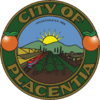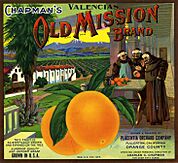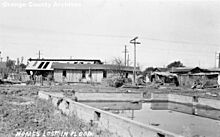Placentia, California facts for kids
Quick facts for kids
Placentia, California
|
|||
|---|---|---|---|
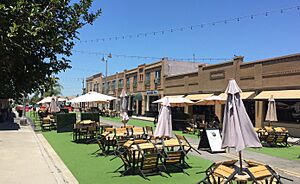
Placita Santa Fe in Old Town Placentia (2021)
|
|||
|
|||
| Motto(s):
"A pleasant place to live."
|
|||
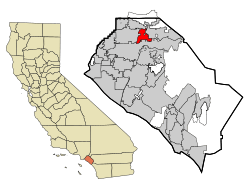
Location of Placentia in Orange County, California
|
|||
| Country | United States | ||
| State | California | ||
| County | Orange | ||
| Incorporated | December 2, 1926 | ||
| Government | |||
| • Type | Council-Administrator | ||
| Area | |||
| • Total | 6.63 sq mi (17.16 km2) | ||
| • Land | 6.61 sq mi (17.12 km2) | ||
| • Water | 0.01 sq mi (0.04 km2) 0.22% | ||
| Elevation | 272 ft (83 m) | ||
| Population
(2020)
|
|||
| • Total | 51,824 | ||
| • Density | 7,748.49/sq mi (3,027.10/km2) | ||
| Time zone | UTC-8 (Pacific) | ||
| • Summer (DST) | UTC-7 (PDT) | ||
| ZIP codes |
92870–92871
|
||
| Area code | 714 | ||
| FIPS code | 06-57526 | ||
| GNIS feature IDs | 1661237, 2411432 | ||
Placentia is a city in northern Orange County, California, United States. Its name comes from a Latin word meaning "pleasant place to live." In 2020, about 51,233 people lived here. The city includes the community of Atwood. Placentia is mostly known as a quiet place where people live and travel to nearby cities for work.
In 1971, Placentia won the "All America City" award. This award is given each year to 10 cities in the United States by the National Civic League.
Contents
History of Placentia
Early Days and First Settlers
Thousands of years ago, the native people called the Tongva lived in this area. Spanish explorers later called them Gabrielenos. It's thought that at least 1,000 native people lived in what is now northern Orange County. A large village called Hutuknga was very close to where Placentia is today.
In 1837, the Mexican government gave the land that is now Placentia to Juan Pacifico Ontiveros. This was part of a large land grant called Rancho San Juan Cajón de Santa Ana.
In 1865, an American pioneer named Daniel Kraemer arrived. He bought about 3,900 acres of land. Many other American pioneers soon followed him, and the community began to grow.
How Placentia Got Its Name
The first local school district was called the Cajon School District. In 1878, its name was changed to Placentia School District. Sarah Jane McFadden, whose husband was an early settler, chose the name. She liked the Latin meaning of "pleasant place to live." Later, the town itself took the name Placentia from the school district.
The first commercial orange grove was started in 1880. Most of the workers were Mexican and Anglo laborers.
Placentia in the 1900s
Around 1910, the town grew from a few scattered farms into a central community. It became an important stop along the Santa Fe Railroad for processing oranges. Later, during the Great Depression, citrus workers in Placentia went on a short strike.
Oil was discovered in 1919. This led to many oil wells being built in eastern and northern Placentia. The town of Richfield, which later became Atwood, was built for oil workers. Most of the oil workers were Mexican laborers. The nearby town of La Jolla, Placentia was also built for similar reasons, often as a separate community for Mexican families.
Between the 1910s and 1930s, some schools in Placentia were separated for White and Mexican students. Isabel Martínez was the first student of Mexican heritage to graduate from Fullerton High School in 1931. She was celebrated as an "exceptional" Mexican. However, only six students from Placentia graduated high school within the next six years.
In 1938, a big flood from the Santa Ana River hit the mostly Mexican areas of Placentia very hard. Almost everything was destroyed except for the La Jolla School Building and three brick buildings. The flood left 3,700 people without homes and made 1,500 homes unlivable. It also caused more than 50 deaths, mostly in the Atwood area.
After World War II, Mexican-American war veterans worked to end school segregation in Placentia. This effort was led by Alfred Aguirre in 1948. He pointed out that some white ranchers thought Mexican students were good at picking fruit, but that "the White kids are too advanced" for them in the classroom.
In the 1950s, the Mexican-American community in Placentia gained more political power. This led to Alfred Aguirre being elected to Placentia's city council from 1958 to 1962. Hundreds of Chicano voters also registered in the city.
In July 2020, Placentia started its own fire department, the Placentia Fire and Life Safety Department. It was the first city to leave the Orange County Fire Authority.
Geography and Climate
Placentia covers about 6.6 square miles (17.1 square kilometers). A very small part of this area is covered by water. State Route 57 (the Orange Freeway) runs through the southwest part of the city. State Route 91 (the Riverside Freeway) passes just south of Placentia. The city includes the neighborhoods of La Jolla and Atwood.
Placentia has a warm-summer Mediterranean climate. This means it has warm, dry summers and mild, wet winters.
Population Information
| Historical population | |||
|---|---|---|---|
| Census | Pop. | %± | |
| 1930 | 1,606 | — | |
| 1940 | 1,472 | −8.3% | |
| 1950 | 1,682 | 14.3% | |
| 1960 | 5,861 | 248.5% | |
| 1970 | 21,948 | 274.5% | |
| 1980 | 35,041 | 59.7% | |
| 1990 | 41,259 | 17.7% | |
| 2000 | 46,488 | 12.7% | |
| 2010 | 50,533 | 8.7% | |
| 2019 (est.) | 51,233 | 1.4% | |
| U.S. Decennial Census | |||
Population in 2010
The 2010 United States Census showed that Placentia had a population of 50,533 people. The city had about 7,677 people per square mile.
The population was made up of:
- 62.1% White
- 1.8% African American
- 0.8% Native American
- 14.9% Asian
- 0.1% Pacific Islander
- 16.3% from other races
- 4.0% from two or more races
About 36.4% of the residents were Hispanic or Latino, of any race.
Most people (99.3%) lived in homes. About 24.6% of the population was under 18 years old. The average age in the city was 36 years.
Economy
Placentia has a large Metrolink train project in its downtown area. This project helps to improve the area. It also plans for more housing near the train station, along with shops and entertainment. These changes are designed to make Placentia a more unique place in Orange County.
The city is also working on the OC Bridges project with the Orange County Transit Authority (OCTA). This project, shared with the city of Fullerton, provides about $580 million to build underpasses or overpasses. These help cars and trains cross safely at major roads like Lakeview Avenue and Rose Drive. Several of these underpasses and overpasses are already finished.
Top Employers
Here are the top employers in Placentia:
| Number | Employer | Employees |
|---|---|---|
| 1 | Placentia-Yorba Linda Unified School District | 2,500 |
| 2 | UCI Health - Placentia | 390 |
| 3 | Hartwell | 300 |
| 4 | Premedia | 305 |
| 5 | City of Placentia | 215 |
Arts and Culture
The George Key Ranch Historic District is a historic citrus farm and Victorian-style ranch house in Placentia. It is now part of the George Key Ranch Historic Park. You can visit the historic house museum, see outdoor displays, and explore a citrus grove. It is listed on the National Register of Historic Places.
The Placentia-Santa Fe District is in the downtown area. The town is also home to the A. S. Bradford House, which is another historic house museum. There is also the 100-year-old Berkenstock Mansion.
In 1973, artists Guillermo Aranda and Ernesto "Neto" Paul worked with art students from the University of California, Irvine (UCI). They painted a large mural (about 8 by 36 feet) on the walls of the Tlatepaque Restaurant. The next year, these artists were invited to paint one of the first pillars at Chicano Park.
Education
Placentia Library District
Placentia has one of California's 13 special district libraries. The Placentia Library District is managed by an elected board. It gets most of its money from property taxes.
The library started in 1914 when the Women's Christian Temperance Union opened a reading room for boys. After residents voted for it, the Placentia Library District officially began on September 2, 1919. The new library district covered about seven square miles of the Placentia area. The library hired its first librarian, Sara Rideout, for $0.25 an hour. The reading room and 193 books were given to the new library. It officially opened to the public on January 15, 1920.
By 1926, a new library building was needed because the community was growing. The building was designed in the Spanish Colonial Revival style by architect Carleton Monroe Winslow. It features beautiful Talavera tiles made by Mexican potter Pedro Sanchez. The new library building opened in March 1927 at 143 S. Bradford Avenue.
In 1974, the library again became too small. It moved to its current location in the Civic Center Plaza. That same year, the library's boundaries grew to match the city's boundaries.
Today, the Placentia Library District has over 330,000 visitors each year. It has issued over 42,000 library cards and holds over 102,000 materials. In September 2018, the library began a major $2.3 million renovation project. This was part of its 100th anniversary. The project was finished on September 14, 2019.
Public Schools
Placentia is part of the Placentia-Yorba Linda Unified School District (PYLUSD). The three high schools in the city are:
- El Dorado High School.
- Valencia High School. This is the oldest high school in Placentia, opened in 1933. It offers an international baccalaureate program and a technology program called ValTech.
- El Camino Real High School. This school was named a "Model Continuation High School" by the California State Department of Education.
Placentia also has several middle schools: Kraemer Middle School, Valadez Middle School Academy, and Tuffree Middle School. There are many public elementary schools, including Brookhaven, George Key, Golden, Morse, Melrose, Ruby Drive, Sierra Vista, Tynes, Van Buren, and Wagner Elementary.
Independent Schools
The Parkview School offers independent study for students from kindergarten to 12th grade. This is for students who are "homeschoolers, student actors, junior athletes, chronically ill, or in other situations where a different way of learning is better."
Transportation
The Metrolink 91/Perris Valley Line train passes through the southern part of the city. Placentia has been preparing for a new train station at Melrose Avenue and Crowther Avenue in Old Town Placentia. The Placentia Station is estimated to cost $35 million. The city will pay $5.4 million. The construction is currently on hold.
In 2007, Placentia became the first city to create a "quiet zone" for cargo trains. This means that trains passing through the city daily do not have to blow their whistles. This is possible because of special technology that activates crossing gates before the train arrives.
The city also has bus routes provided by the Orange County Transportation Authority's bus routes:
- Route 129 runs along Kraemer Blvd.
- Route 71 runs along Rose Drive.
- Route 26 runs along Yorba Linda Blvd.
- Route 123 runs along Chapman Avenue.
- Route 30 runs along Orangethorpe Avenue.
In 2002, a train collision happened in Placentia. A freight train crashed head-on with a Metrolink train. Two people died, and 22 were seriously injured.
Notable People
- Agent Orange, a punk rock band.
- Kevin Blankenship, professional baseball player.
- Michael Chang, professional tennis player and French Open champion.
- Peter Daut, news presenter.
- Chris Draft, NFL professional football player.
- Janet Evans, Olympic swimmer and four-time gold medalist.
- Jackie Francois, musician.
- Jason Freese, musician, keyboard player for Green Day.
- Josh Freese, musician, drummer for the Foo Fighters.
- Michele Granger, softball pitcher.
- Courtney Hicks, figure skater.
- Kottonmouth Kings, hip hop group.
- Kingspade, hip hop group.
- Phil Nevin, baseball player.
- Kherington Payne, So You Think You Can Dance contestant.
- Shawn Ray, bodybuilder.
- Johnny Richter, rapper.
- Equanimeous St. Brown, NFL professional football player.
- Corrie ten Boom, a Holocaust survivor and author.
- Brett Tomko, Major League Baseball player.
- Bret Boone, Major League Baseball player.
See also
 In Spanish: Placentia (California) para niños
In Spanish: Placentia (California) para niños



